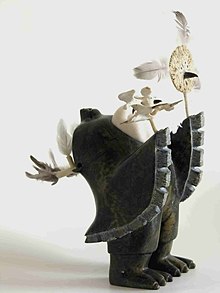
Back Inuit-Kunst German Art inuit French Eszkimó művészet Hungarian 이누이트 미술 Korean Inuittisk kunst NN Arta inuită Romanian Inuitisk konst Swedish
This article needs additional citations for verification. (August 2011) |

Inuit art, also known as Eskimo art, refers to artwork produced by Inuit, that is, the people of the Arctic previously known as Eskimos, a term that is now often considered offensive. Historically, their preferred medium was walrus ivory, but since the establishment of southern markets for Inuit art in 1945, prints and figurative works carved in relatively soft stone such as soapstone, serpentinite, or argillite have also become popular.
The Winnipeg Art Gallery has the largest public collection of contemporary Inuit art in the world.[1] In 2007, the Museum of Inuit Art opened in Toronto,[2] but closed due to lack of resources in 2016.[3]
- ^ "History | Winnipeg Art Gallery". www.wag.ca. Archived from the original on 2012-04-10.
- ^ "Museum of Inuit Art". Archived from the original on 2018-04-22. Retrieved 2020-01-25.
- ^ 'Small but mighty' Canadian Museum of Inuit Art closing its doors